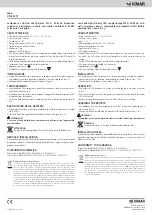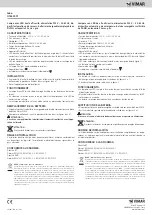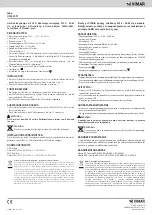
Viale Vicenza, 14
36063 Marostica VI - Italy
www.vimar.com
49400272B0 02 1804
Idea
H16442.01
Lampada con LED ad alta efficienza 230 V~ 50-60 Hz, dispositivo
automatico d’emergenza, batteria ricaricabile sostituibile al Ni-MH,
autonomia 2 ore, grigio.
CARATTERISTICHE
.
• Tensione di alimentazione: 230 V~ ±10%, 50-60 Hz.
• Flusso luminoso: 3 lumen.
• Assorbimento: 1 W.
• Batteria ricaricabile al Ni-MH 4,8 V, 80 mAh.
• Tempo di ricarica batteria: 48 ore.
• Autonomia: 2 ore.
• Apparecchio LED di classe 1.
• LED bianco ad alta efficienza e lente incorporata ad angolo ridotto; l’alimentazione
a corrente costante consente di avere sempre la stessa luminosità del LED per tutta
la durata della carica.
• LED di colore ambra per indicazione di presenza rete e ricarica della batteria (figura 1)
• La lampada non è comandabile tramite regolatore.
• Apparecchio di classe II .
• Installabile su superfici normalmente infiammabili
.
INSTALLAZIONE.
• Al momento dell’acquisto la batteria non è collegata; prima di installare l’apparec-
chio collegare la batteria seguendo la procedura illustrata nelle figure da 4 a 7.
• Collegare quindi l’apparecchio come indicato in figura 2.
FUNZIONAMENTO.
• La lampada con LED svolge la funzione di illuminazione ausiliaria in caso di mancan-
za di alimentazione da rete.
• Al ripristino della tensione di rete la lampada si spegnerà automaticamente ed il LED
di colore ambra si accenderà.
• La ricarica della batteria avviene in modalità continua in presenza della tensione di
rete.
SOSTITUZIONE DELLA BATTERIA.
• L’apparecchio contiene una batteria ricaricabile sostituibile solamente con ricambio
Vimar 00910.
• Sostituire la batteria seguendo la procedura illustrata nelle figure da 4 a 7.
ATTENZIONE!
L’accesso al vano batteria deve sempre essere effettuato con l’apparecchio
non alimentato.
ATTENZIONE!
Smaltire le batterie negli appositi cassonetti per la raccolta differenziata.
REGOLE D’INSTALLAZIONE.
L’installazione deve essere effettuata da personale qualificato con l’osservanza delle
disposizioni regolanti l’installazione del materiale elettrico in vigore nel paese dove i
prodotti sono installati.
CONFORMITÀ NORMATIVA.
Direttiva BT. Norme EN 60598, EN 60598-2-2, EN 60825-1
Direttiva EMC. Norme EN 61547, EN 61000-3-2, EN 61000-3-3, EN 55015.
Lamp with high-efficiency LED, supply voltage 230 V~ 50-60 Hz, auto-
matic emergency device, replaceable rechargeable Ni-MH battery,
operating time 2 hours, grey.
CHARACTERISTICS
.
• Supply voltage: 230 V~ ± 10% 50-60 Hz.
• Luminous flux: 3 lumen.
• Input: 1 W.
• Rechargeable Ni-MH battery 4.8 V, 80 mAh.
• Battery charging time: 48 hours.
• Operating time: 2 hours.
• LED appliance of class 1.
• High-efficiency white LED and integral narrow angle lens; the constant current sup-
ply makes the LED always have the same brightness for the entire duration of the
charge.
• Amber LED to indicate mains on and battery charging (figure 1).
• The lamp cannot be controlled with a dimmer.
• Appliance of class II .
• Can be installed on normally flammable surfaces
.
INSTALLATION.
• At the time of purchase the battery is not connected; before installing the appliance,
connect the battery by following the procedure illustrated in figures from 4 to 7.
• Then connect the appliance as indicated in figure 2.
OPERATION.
• The lamp with LED performs the function of auxiliary lighting in the event of a mains
failure.
• When the mains power returns the lamp will automatically switch off and the amber
LED will switch on.
• Battery charging takes place continuously when there is mains voltage.
CHANGING THE BATTERY.
• The appliance contains a rechargeable battery that can only be replaced with a
Vimar spare 00910.
• Change the battery by following the procedure illustrated in figures from 4 to 7.
WARNING!!:
The appliance must not be powered when accessing the battery compartment.
WARNING:
Dispose of batteries in the specific differentiated collection bins.
INSTALLATION RULES.
Installation should be carried out by qualified personnel in compliance with the current
regulations regarding the installation of electrical equipment in the country where the
products are installed.
CONFORMITY TO STANDARDS.
LV directive. Standards EN 60598, EN 60598-2-2, EN 60825-1.
EMC directive. Standards EN 61547, EN 61000-3-2, EN 61000-3-3, EN 55015.
RAEE - Informazione agli utilizzatori
Il simbolo del cassonetto barrato riportato sull’apparecchiatura o sulla sua confezione indica
che il prodotto alla fine della propria vita utile deve essere raccolto separatamente dagli altri
rifiuti. L’utente dovrà, pertanto, conferire l’apparecchiatura giunta a fine vita agli idonei centri
comunali di raccolta differenziata dei rifiuti elettrotecnici ed elettronici. In alternativa alla gestione
autonoma, è possibile consegnare gratuitamente l’apparecchiatura che si desidera smaltire al
distributore, al momento dell’acquisto di una nuova apparecchiatura di tipo equivalente. Presso
i distributori di prodotti elettronici con superficie di vendita di almeno 400 m
2
è inoltre possibile
consegnare gratuitamente, senza obbligo di acquisto, i prodotti elettronici da smaltire con di-
mensioni inferiori a 25 cm. L’adeguata raccolta differenziata per l’avvio successivo dell’apparec-
chiatura dismessa al riciclaggio, al trattamento e allo smaltimento ambientalmente compatibile
contribuisce ad evitare possibili effetti negativi sull’ambiente e sulla salute e favorisce il reimpie-
go e/o riciclo dei materiali di cui è composta l’apparecchiatura.
WEEE - Information for users
If the crossed-out bin symbol appears on the equipment or packaging, this means the pro-
duct must not be included with other general waste at the end of its working life. The user
must take the worn product to a sorted waste center, or return it to the retailer when pur-
chasing a new one. Products for disposal can be consigned free of charge (without any new
purchase obligation) to retailers with a sales area of at least 400 m
2
, if they measure less
than 25 cm. An efficient sorted waste collection for the environmentally friendly disposal of
the used device, or its subsequent recycling, helps avoid the potential negative effects on
the environment and people’s health, and encourages the re-use and/or recycling of the
construction materials.






















